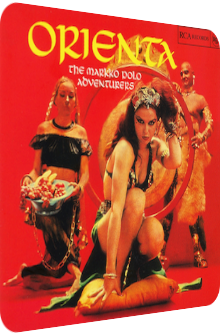
The Markko Polo Adventurers
Orienta
1959
Happiness supreme, that's all I feel when I'm talking about Orienta by the Markko Polo Adventurers. I don't know where to start, as the album is chock full of peculiarities. For one, the Markko Polo Adventurers is a faux-band that never existed. In fact, the project came to life in 4 recording sessions through the great minds of composer and arranger Gerald Fried – Star Trek and Gilligan's Island fame – and producers Simon Rady and Michael H. Goldsen, the latter one being famous for promoting Hawaiian music in the U.S.
The iconic band setup on the front cover was created in order to fool the audience. Although the obligatory beautiful woman on many an Exotica album was clearly meant as a selling-point that couldn't fool the listener into thinking that this beauty was featured as a singer on the album, the faux-band picture was indeed a terrific marketing ploy that further enhanced the supposed originality and truth about Orienta. Secondly, the album mixes lots of field recordings with both original tunes and renditions of classics. While field recordings also play an important rule in albums by Arthur Lyman and Tak Shindo, they were still uncommon and thus embraced by the curious listeners. Nothing else is more effective in transporting the aura auf exotic places than chirping birds of paradise and tropical rainstorms. And Orienta is loaded with these aural landscapes that are as important as the music itself.
Thirdly, Fried was keen on delivering a suitable record for the ever-growing group of audiophiles who was craving for high-fidelity stereo records in order to showcase their tube amplifiers to amazed friends and relatives – on a side note, history repeated itself by the end of the 90's when the home cinema market was established and everyone wanted to watch the latest movies as well as classics in Dolby Digital encoded sound. Fried and Enoch Light were just the forerunners of this trend. Fourthly, the album is quite funny, doesn't take itself too seriously and actually tries to tell short story vignettes via music and sounds – in stark contrast to Eden Ahbez's Eden's Island of 1960, for instance, who told the story of his enchanted island via lyrics and spoken word interludes. And lastly, all of these obscure facts made this a cult album that was re-released on CD in 2004 and is now easily available on digital music stores as well! I cannot stress how surprising this fact is.
One of the best Exotica albums in terms of quality and its concept, but also one of the most curious and experimental examples is indeed re-issued, all the while other equally important classics remain physically lost to collectors and fans up to this date. Anyway, the 12-track Orienta is an album not to be missed, as it really does take the listener on a short 35-minute journey, of which I will exemplify the most important landmarks below.
Song Of India – Beggars' Procession marks the beginning of an exciting journey and starts with a bang or, to be more precise, a Chinese gong. The sky-high voice of a chantress voiced by Marni Nixon plus mumblings and snippets of various conversations create the atmosphere of a bustling street in an Indian city. Bongos, tambourines and a melody that oscillates between the Middle and the Far East is played on vibraphones and shawms. Bass pluckings create a Western, jazzy atmosphere later on, but an added sitar and ubiquitously clanging rattles are the limelight ingredients. The song as well as the setting were influenced by Nikolai Rimsky-Korsakov's opera called Sadko, but the only remainder is the chanting woman, everything else is refreshingly exotic.
Yokohama Ferryboat continues with the bustling atmosphere: a steamer horn, crying sea gulls, and a joyful melody played on oboe and flute is heard, while the inclusion of the banjo is totally unexpected, crushing the otherwise clichéd Japanese style of the song. The song ends with a murmuring cluster of people. Rain In Rangoon is next and is a very mellow song which I consider the best song off Orienta. Beautiful paradisiacal flute melodies, gentle bamboo drums and the croaking noises of a nearby swamp create a vista of clean freshness. Thunderstorms and gorgeously pristine mallet instruments as well as various bells form a great counterpoint to the rumbling thunders. The song oscillates between quiet and livelier passages, and the incisiveness of the flute makes this a bright song that contains bits of mystery due to cascading bells and arcane shawms. Pure bliss!
The electrifying bar atmosphere of Madam Sloe Gin's follows, and the mixture of marimbas, vibraphones, cowbells and a banjo is as curious as it is effective. The clarion drums and the cheering crowd create a faux-live atmosphere that is unprecedented to this day in the realm of the Exotica genre. Another track worth mentioning is a rendition of Raymond Scott's Mountain High, Valley Low. The benchmark version of this tune has been conducted by Warren Barker on his album A Musical Touch Of Far Away Places, but The Markko Polo Adventurers' cut earns a good second place – it is without a doubt the most majestic tune on Orienta. The infamous Chinese gong starts the over 4 minutes long tune. An quiescent atmosphere is created with the use of smooth tambourines, various mallet instruments, flutes, shawms and once again the haunting voice of Marni Nixon. In contrast to Warren Barker's version, the tension increases due to staccato rattles and a short crescendo of all instruments. Soon, the pompousness returns with the polyphonous, string-laden altogether, then resembling Barker's version that was recorded in the same year.
Sheherezade is again inspired by Rimsky-Korsakov's opera and is obviously overly Oriental but also surprisingly festive and hectical with various drums, Middle Eastern-flavored flute melodies and Western accompaniments on the same instrument. Short cacophonous intersections amplify and underline the alienating setting, but the bass guitar pluckings are again reminiscent of Western Jazz songs and function as a counterweight. For a very short second, cascading harp strings can be heard, and as soon as the ears adjust to their mellowness, they fade out for good.
Next is a truly unique rendition of the 1904 U.S. Folk song Frankie And Johnny, called Limehouse Blues. Japanese claves can be heard and the eerie oboe melody is played before the song shifts into a speedy and cheeky saloon song with gun shots, cowbells, police sirens and whistling policemen. Once Frankie is caught by the police for the murder she committed, the eerie melody is heard again. One more time the trio of producers mixes distinctly Oriental sounds with Western melodies, but the experiment fails in my opinion, for the shifting between gloomy danger and lively action doesn't work for me. The production quality, however, is flawless as usual, so it's just my personal taste that prevents this song from being a consideration by me. Another completely different aural picture is presented next: Night Of The Tiger is a pitch-perfect example of concept music. The song displays the power of this beast, but first, the setting is peaceful and festive with picturesque Far Eastern flutes and slightly scary shawms. Suddenly, the tiger strikes and kills his victim. Tense drums are played in the background while the creature is roaring. The tempo increases until all hell breaks loose. But once the beast is killed, the chirping of crickets continues and everything is right again.
Nagasaki contains a surprisingly bold amount of Rock'n Roll and Jazz motifs. A Japanese string instrument plays along, and the addition of vibraphones, bass and an oboe form the opposite parts to the Rock sections. A gleaming trumpet melody is later added, completing the stylistic variety. The final playful song is called Runaway Rickshaw and increases the tempo of its gallopping rhythm with glinting vibraphone backings, melodious flute sections and a slow-down in the middle when the rickshaw reaches the peak of the mountain, followed once more by an increasing tempo and the – you guessed it – mandatory Chinese gong that ends the album in the way it began, thus coming full circle after 35 minutes.
The sound quality, the atmosphere, the aura – Orienta is an organic album of the gargantuan kind! To my mind, the album's concept is as keen on the music as is its focus on the flow. The term flow is found quite often on the web and even in scientific papers of all kinds, and yet it is used differently, depending on the various fields of resarch. I use it in order to stress the harmony, the build-up, the nature of Orienta as a concept album, the bits in-between its sound fissures. Who would have thought that ordinary Exotica, Lounge or Easy Listening music could be this exciting, this well-produced and yet so cheekily fake by playing with the listener's expectations?
Don't mistake Orienta's focus: if you want to listen to gorgeously melodious songs, this album is probably not for you. Orienta is all about the barely perceptible glints of an adventurous feeling, the aural vistas that are painted by the exotic instruments and the little stories it tells; it's a cinematic album. Sure, you can tear the songs apart from each other and put them into various playlists, but you'd miss the careful setup, the overarching rhythm, to make it short: the flow. And don't forget that this was recorded in 1958 and released in 1959! This is no lackadaisical album to cash in on the success of Exotica albums and Hi-Fi stereo records, no, everything is perfectly crafted, well produced and refreshingly unique in its rich lushness.
Here we have the very rare pre-Dark Side Of The Moon case of an album that is actually depicting a journey. Yep, it is clichéd at times, but the field recordings and the various build-ups via exotic instruments are tremendously satisfying and catapult this singular milestone by the trio into the Exotica shangri-la. That the Markko Polo Adventurers only exist on paper is another obscure fact in the rich history of the genre. Why Fried, Rady and Goldsen never picked up the threads they left on this album is beyond me. Anyway, this is one of the best Exotica albums. Due to its soothing songs and field recordings it also provides a good, if rather strange listening session for Ambient lovers or even Progressive Rock fans … seriously! If there is one album that coalesces the best ideas of the genres Ambient and Exotica, this is it.
Further reading:
While it's only natural to consult the Wikipedia for information of all kinds, the Orienta entry of the encyclopedia is especially noteworthy and informative. A must-read!
Exotica Review 042: The Markko Polo Adventurers – Orienta (1959). Originally published on Mar. 3, 2012 at AmbientExotica.com.
